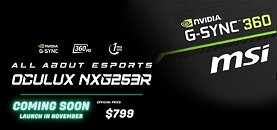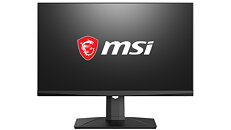Wednesday, September 2nd 2020

MSI Unveils The Oculux NXG253R 360Hz eSports Gaming Monitor
MSI, world's leading manufacturer for true gaming hardware, is proudly expanding the hardware possibilities for gamers. This time, we are honored to introduce our latest flat eSports Gaming Monitor: Oculux NXG253R. MSI Oculux NXG253R supports the latest NVIDIA G-SYNC technology, accompanied with extremely high refresh rate of 360Hz and fast response time of 1 ms GTG, giving gamers the smoothest gaming experience. The mystic light feature allows you to personalize your gaming rig, giving you a full grip of your game in a blink of an eye. In addition to providing the best hardware performance, MSI is committed to providing players with the best gaming experience, cooperating with NVIDIA, and introducing the latest NVIDIA Reflex Latency Analyzer function.NVIDIA Reflex Latency Analyzer is a revolutionary system latency measurement tool integrated in new MSI Oculux NXG253R 360Hz G-SYNC Esports displays arriving this Fall. PC performance for competitive gaming is about responsiveness — how quickly your display updates after mouse clicks or movements. The Reflex Latency Analyzer detects clicks coming from the mouse and then measures the time it takes for the resulting pixels (i.e. a gun muzzle flash) to change on screen. This type of measurement has been virtually impossible for gamers to do before now, requiring over $7000 in specialized high-speed cameras and equipment. Reflex Latency Analyzer provides a much more complete and accurate understanding of mouse, PC, and display performance. Now with Reflex Latency Analyzer, competitive gamers can start a match with confidence, knowing their system is operating exactly as it should be.
NVIDIA G-SYNC Technology
MSI Oculux NXG253R is the first MSI gaming monitor that utilized the extremely coveted NVIDIA G-SYNC technology. With the NVIDIA G-SYNC technology, Oculux NXG253R can produce stunning tearing-free visuals. This gives gamers a buttery smooth gaming experience and allows gamers to react to scenes that are true to the situation.
Extremely High Refresh Rate & Short Response Time
The MSI Oculux NXG253R is equipped with 360Hz refresh rate and 1 ms response time. It will undoubtedly be beneficial to professional gamers, especially those that are involved in fast moving game genres. Games like first person shooters, fighters, racing sims, real-time strategy and sports will no longer look quirky since our monitor will be able to keep up with any FPS your graphic card produce.
NVIDIA Reflex Latency Analyzer
MSI Oculux NXG253R 360Hz G-SYNC eSports displays now support the revolutionary NVIDIA Reflex Latency Analyzer, giving competitive gamers an accurate measurement of system latency for the first time.
Source:
MSI
NVIDIA G-SYNC Technology
MSI Oculux NXG253R is the first MSI gaming monitor that utilized the extremely coveted NVIDIA G-SYNC technology. With the NVIDIA G-SYNC technology, Oculux NXG253R can produce stunning tearing-free visuals. This gives gamers a buttery smooth gaming experience and allows gamers to react to scenes that are true to the situation.
Extremely High Refresh Rate & Short Response Time
The MSI Oculux NXG253R is equipped with 360Hz refresh rate and 1 ms response time. It will undoubtedly be beneficial to professional gamers, especially those that are involved in fast moving game genres. Games like first person shooters, fighters, racing sims, real-time strategy and sports will no longer look quirky since our monitor will be able to keep up with any FPS your graphic card produce.
NVIDIA Reflex Latency Analyzer
MSI Oculux NXG253R 360Hz G-SYNC eSports displays now support the revolutionary NVIDIA Reflex Latency Analyzer, giving competitive gamers an accurate measurement of system latency for the first time.


25 Comments on MSI Unveils The Oculux NXG253R 360Hz eSports Gaming Monitor
Every new monitor announcement from now on will be met with "360Hz or bust, my eyes can totally tell the difference".
Have to watch avatar :-)
It's time to stop. Perhaps one of the most worthless technological push in the PC gaming space.
Yeah, yeah, I know you "can totally tell the difference". I just don't believe it, meanwhile servers for popular games have sub-60hz tick rates.
I mean we went from reading about display specs to reading about gaming display specs and now about esports gaming display specs. Clearly the improvements are targeting an increasingly more niche audience. I'd much rather go back to reading about improvements that benefit everybody: better dynamic range, improved color gamut, low lag.
The writeup already makes it clear it's a 1ms monitor, id say it's the same tech as the 251R and 252R
post.m.smzdm.com/p/a3g7pp27/
The difference only shows for faster displays shown by pixel trails. Wrong again.
It is not debatable. It is scientifically established how fast they are perceived. The formula is this;
MPRT=[GtG² + (0.8 Frame Time²)]^½
I mean, sure, the sooner you see it, the sooner you can react. But at 120Hz we're already talking like 8ms between two frames. Not much time left to shave off there.
144Hz displays are good for 8ms, 240Hz 6ms, 360Hz 4ms, 480Hz 2ms, imo.
I wrote this previously, framerate increases makes sense when pixel latency<frame latency. It ain't much, but consider GtG latency has 1 weight whereas frame latency has 0.64.Let's consider where the MPRT is equal to perceived latency.
- 240Hz(4.2ms frame period) displays need to have 2.5ms GtG levels, in order to have 4.2ms perceived latency.
- 360Hz(2.8ms frame period) displays need to have 1.7ms GtG levels, in order to have 2.8ms perceived latency.
- 480Hz(2.1ms frame period) displays need to have 1.25ms GtG levels, in order to have 2.1ms perceived latency.
We are wildly off those numbers, there.The refresh rate at the factory comes entailed with overdrive calibration, so it enables on one hand,
- Better undershoot-overshoot balance,
- Clearer image,
- Higher utilization of a faster overdrive voltage.
Most of the time overdrive just meets the required refresh rate at the highest rate.Okay, I try to tell mprt one last time,
- 144Hz display needs to have pixel switching time of 240Hz in order to have 144Hz native display perceived blur.
- 240Hz display needs to have pixel switching time of 400Hz in order to have 240Hz native display perceived blur.
- 360Hz display needs to have pixel switching time of 600Hz in order to have 360Hz native display perceived blur.
Those who say who needs it just needs to deduce from that example how improbable those requirements are without a native refresh rate & strobe simultaneously.That's just what I said: there are useful for precious few.